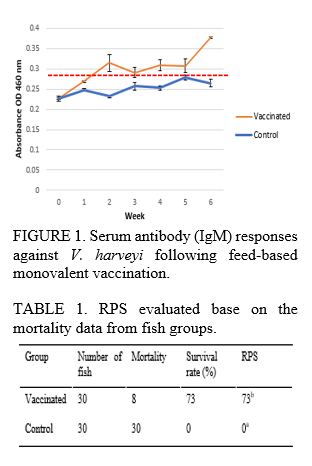EFFICACY OF A FEED-BASED VACCINE AGAINST Vibrio harveyi IN ASIAN SEABASS Lates calcarifer
Vibrio harveyi is an important aquaculture pathogen that causes vibriosis and infects a large number of fish species. Vibriosis is regarded as an epizootic, described as a global outbreak of communicable disease temporarily occurring in limited geographical areas. Vaccination is one of the alternatives to overcome the disease outbreaks and was reported to be more effective and safer to human and environment than antibiotics. Thus, in this study, a newly developed feed-based killed V. harveyi vaccine was used to study the immune response and efficacy of this kind of vaccine in Asian seabass.
A total of 270 Asian seabass, Lates calcarifer of 15.8 ± 2.6 g were separated into 2 groups, in triplicate. Fish of Group 1 was not vaccinated and Group 2 was vaccinated with feed-based killed Vibrio harveyi vaccine. Vaccinations were done on days 0 and 14 orally using the feed-based bacterin vaccine at 4% bodyweight. At week 4, 30 fishes from each group were challenged with live V. harveyi and the survival rate was determined. Samples of serum for antibody study were collected at 7-day intervals throughout the 6-week study period. Following vaccination by the feed-based vaccine, IgM antibody levels showed significant (p<0.05) increase in serum as early as week 2 and peaked at week 6 (Figure 1). This resulted in a significantly higher protection (p<0.05) following challenge with 2.3 x 107 CFU mL-1 of live V. harveyi than unvaccinated groups (Table 1). This feed-based vaccine offers an opportunity for a comprehensive immunization regime.
